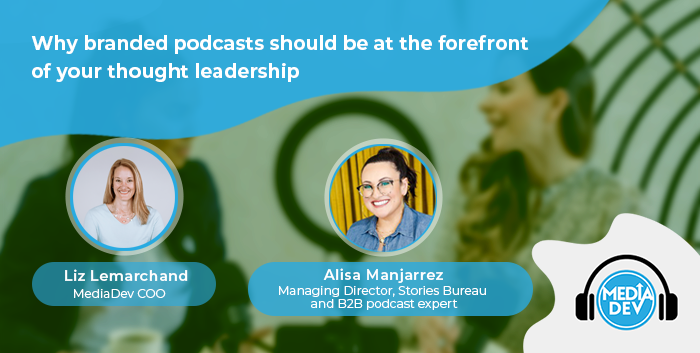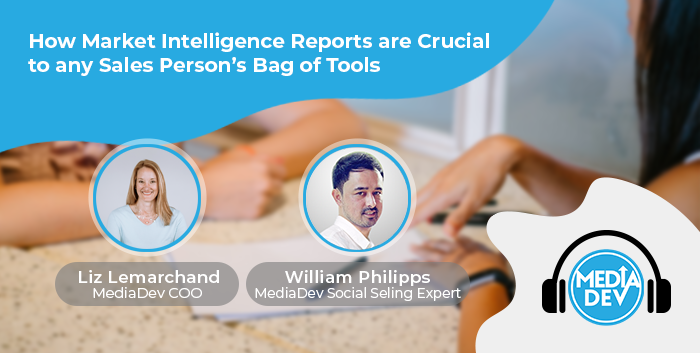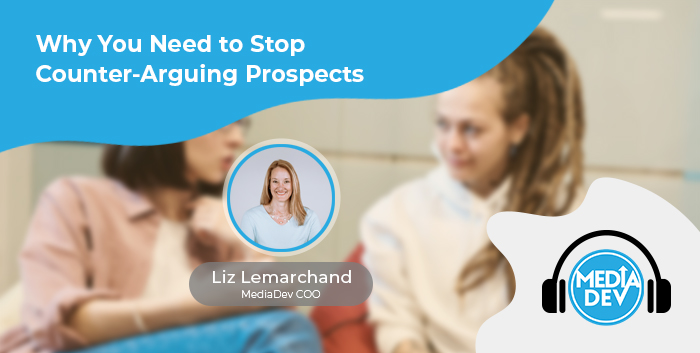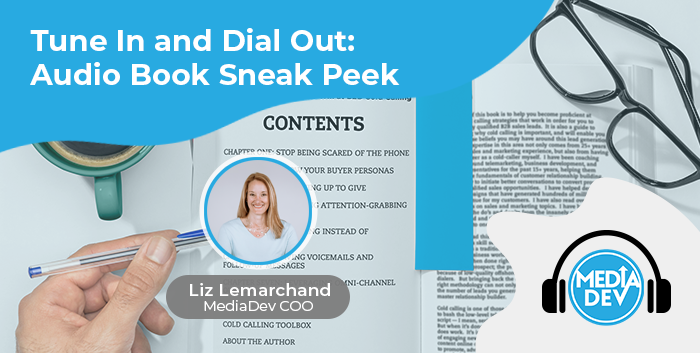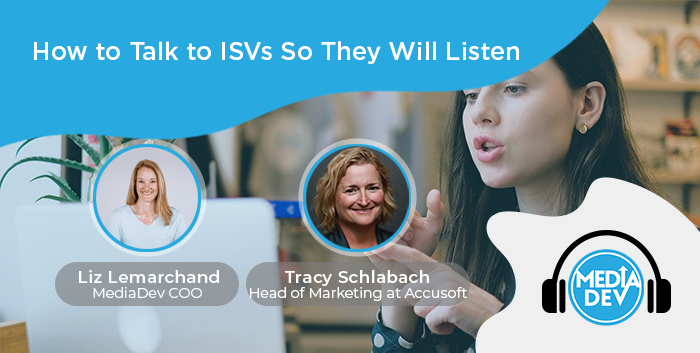Listen to this episode where Liz Lemarchand, MediaDev’s COO talks with Dan Outcalt, an OEM sales expert, about why it’s critical to have a big OEM sales funnel, perhaps even more so when selling to end-user customers, and how to build. Tune in!
Listen to the episode on Apple Podcast, Google Podcasts, Spotify, Breaker, Pocket casts, RadioPublic, or Anchor, or read the transcript below.
SHOW NOTES
Biggest mistakes salespeople make when it comes to OEM outreach [00:03:24]
Why is it important to create a big OEM sales funnel, perhaps even more so when selling to end-user customers? [00:06:54]
How can someone go about getting started building an OEM sales funnel? [00:09:14]
Tips for people who are new to ISV-OEM sales on how to get started building an OEM sales funnel? [00:09:14]
Why so many marketers have difficulty getting their heads wrapped around ISV-OEM? [00:13:07]
Why is it important for an OEM sales teams to have valuable marketing support? [00:20:21]
If you’ve enjoyed this episode, please subscribe via Apple Podcast | Google Podcasts | Spotify | Anchor to automatically get the next ones!
Thanks for Listening Today!
Share it with someone you believe will also benefit from listening to it. Use the share buttons below! They’ll thank you for it.
Transcript
Liz Lemarchand
How is it that innovative software solutions have the ability to change the world yet they don’t sell themselves? How is it that I know my target market but I’m not able to generate enough sales opportunities? How do I even get started to create visibility for my brand when I’m not an expert in marketing? That is the question and this podcast will give you the answer. Welcome to SMplified: Software Marketing Made Simple!
Hey everyone, this is Liz from MediaDev and today I am joined by an OEM sales expert, Dan, Hi Dan. It’s great to have you here today.
Dan Outcalt
Hi, Liz, how are you?
Liz Lemarchand
I’m good. Thanks for taking the time to join us. I’m really excited to talk to you. You and I have known each other for quite some time and obviously have worked together through a few different companies you’ve worked up, but maybe you could start by telling our audience a little bit about yourself, your background, and how it is that you’re an expert on OEM sales. And ISV targeting ISV.
Dan Outcalt
Sure. Well, thanks, Liz. So I grew up in the Midwest, went to school in the Midwest, migrated out to Denver, lived there for 25 years roughly. And then San Diego. And I’m coming to you now actually from Costa Rica. I’ve retired just a few months ago and andbought a house in Costa Rica, so Pura Vida. But so during that time, I originally started out, spent a couple of years in the hotel business. Quickly found out that it wasn’t my calling. I migrated into technology sales and kind of have been doing that ever since. So in short, about four decades of sales experience, equally split between managing high performance sales teams and being an individual better and probably 15/18/20 somewhere in that range, years of experience management, OEM sales organizations. So there’s some key differences between OEM and direct sales. As I discovered along the way. But very exciting if you look at it from the standpoint of where I started. I’m going to date myself here a little bit, but the IBM PC was brand new when I started selling technology. And we competed directly head on against the IBM PC. Which the original, you know, before the 286, the original IBM PC running a rudimentary version of Windows was very archaic. Definitely a dinosaur, but you know you can see the wave of the future that just came, came forward full force and people started using Microsoft Word for Windows. That was my first introduction to a program that was easier to use than WordPerfect, and, you know, migrating from Lotus 123 to using XLS a spreadsheet and some other things. So long road, exciting. I love technology.
Liz Lemarchand
Ohh gosh.
Dan Outcalt
And I built a career.
Liz Lemarchand
Amazing. So I can imagine that given your experience, you’ve seen a lot of people fail at OEM sales. So what are some of the biggest mistakes you’ve seen salespeople make when it comes to OEM outreach?
Dan Outcalt
You know, OEM is very different. I mean the word original equipment manufacturer kind of came from the old days where somebody would supply computer chips to a manufacturer or they would supply graphics cards, or they would write a piece of software that the vendor didn’t want to write themselves. A more modern case, in case in point is most companies don’t go out and write their own analytics. If they have a software product that does, let’s say IT service management or something like that, they may opt to go out and select an analytics product from a myriad of different companies that they could just embed into their solutions, so that lets them get the product to market faster and it lets them go out and capture market share more quickly. So the problem with that is there’s a buying cycle that occurs when they’re creating the application or when they’re building the system, and you have to really be tuned into when that buying system is. And there’s a lot of regression testing and other things that go into that so what you wind up seeing is, I don’t know. Let’s take one of the multifunction printer manufacturing companies. When they’ve put software in their device, they ship it on a global l basis and it has to work. It has to work 24 by 7 by 365. Or they’re getting flooded with support calls because they may ship a couple of million devices and everything has to be perfect with that. So there’s more testing involved. Typically, they’re going to sign up for a multi-year contract. They’re not going to sign up for a one-year contract as they may spend more time than that just testing to see if the software or the hardware actually works with their customer base and their application. So you may have a better product. But if someone just made a decision and they signed a three or a four-year deal, you may have to wait on the sideline until it’s the right time for them to consider an upgrade. And then on top of that, you probably need to be there a year plus early so they can do the requisite amount of regression testing to see if the product actually works. So the short answer is you really need more pipeline. Because you have to dial into all these different buying cycles and it’s not an internal use application where you know they can put something in place if it doesn’t work, just tell everybody in the company. hey, quit using this app for a week while we do some testing with it. When they go live and they ship on a global basis, everything has to be perfect. So. Conversations with sales teams was always around. Look, you probably need to have more than a three to 1 pipeline like you would in direct sales because of all the buying cycles and because of the lengthy decision processes it, it just becomes that much more critical.
Liz Lemarchand
So you’ve kind of touched on this, you know the importance of having a big OEM sales funnel, but so you just talked about 3:00 to 1:00. Why do you think it’s so important to have such a big OEM sales funnel even more so than when selling to end user customers? Is it because just of the long sales cycle like you said? Or are there other reasons as well that make it even more important.
Dan Outcalt
Yeah, well, people are resistant to change, right? So you have an IT organization or development organization and they are busy. They’re working on a lot of different things and all of a sudden, you know, somebody comes to them from executive management and says, hey, what about rewriting their application and coming out with a new release and maybe we change out the analytics or maybe we change out the OCR function or we change out one of these key OEM contracts that we have. So now they’re faced with creating a new application, writing a bunch of new code, and doing all of this testing. So the path of least resistance is for someone to say, hey, why don’t we just extend the contract another one or two years? I had that situation when I was working for Oracle. Actually the second largest software company in the world we had a relationship with one of our primary suppliers and all of a sudden Oracle bought a company. That company was a competitor and you know they immediately got the hair up on the back of their neck and said, well, I don’t know if we can do business with you guys anymore now because you compete with us in this other area so long story short, they said we’re done. We’re not going to work with you anymore. They came back for multiple contract extensions because they couldn’t architect the product out within a two-year time frame and they just had they’re stretched thin on resources to start with. So there’s a lot of complexity around it in that just translates again into having more pipeline because at the end of the day you can have a bunch of people shaking their heads saying we want to make this change, but if they’re stretched for resource, the path of least resistance is just to extend the existing contract and not bother.
Liz Lemarchand
Right, right. That makes sense. So how can someone go about getting started building an OEM sales funnel? I mean, what tips would you give to someone who wants to do this and is perhaps new to ISV OEM sales.
Dan Outcalt
Yeah, so I’m thinking about three different things here at the same time. Let me try to sort through a little bit. I remember one of the guys on my team that I hired, he was new to OEM and he came in. We sat down in our in our office. And we’re having a conversation. And he said so look, I got to go out and get a funnel quickly. I’m used to making money. I got a family. I got three kids, etcetera. How do I do this? And the advice that I gave them at that point was pretty simple. I said look, just buy a bunch of airline tickets. And fly to every one of your customer locations and sit down with them, take them to dinner, have lunch, meet in the office, whatever, and just ask them point blank, how can I help you? So take the customer base, get close to them, make sure that you’re aware of all the buying cycles. And and you can be there at the right time when things come up or you have the opportunity to expand your presence with them. And the other thing that that I used to focus quite a bit on with my teams really focused around just nothing happens until you get a face to face conversation with a customer. So it’s very seductive to get up in the morning and say, oh, man, look, I got all these emails I’ve got to take a look at and when we get busy on that and then you all of a sudden have a report that your manager wants or, you know, you log into sales force and you look at your funnel and your pipeline and all of these different things, so you’re busy. And you, you could be really busy. You could be behind in terms of getting stuff done. But at the end of the day that doesn’t move the needle in terms of generating net new pipeline opportunities. So when you get to the point where there’s a conversation, it could be a zoom call, Teams call, you know, whatever could be a phone call. It doesn’t really matter, but at least you got an interaction with the customer. Then you can start the way. Is this a viable opportunity or not? It’s simple, and you’ve probably heard this many times before, but people need to block off time in their calendar. They need to ignore their boss. They need to ignore e-mail. They just need to focus for a set period of hours on doing nothing but outreach to customers and trying to spawn new conversations. I’ve just seen it too many times. Well, I’m really busy. I’m like, OK, well, how many hours a week are you spending on the phone, prospect? Well, you know, I’m. I’m doing an e-mail campaign. OK, that’s great. 98.6% of those emails are going to be completely ignored. So what else are you doing right? Because and then the other mistake that I’ve seen a few times in my career is people will get someone on the phone and they’ll say, well, we’re already using a competitive solution. Why is yours different and they’ll start going into a sales pitch right away at the end of the day? That’s the time to say I’m happy to have a conversation with you, but I can’t do it right now. Can we set something up for Tuesday at 8:00 AM, or would something later in the week like Thursday or Friday in the afternoon be better? So move towards. Setting up the conversation if you can’t get that conversation scheduled, you don’t have any kind of a viable opportunity and you need to just go on to the next the next person, the next company, and the next opportunity.
Liz Lemarchand
Yeah, that’s great. That’s great tips right there. Thank you. So why do you think so many marketers have difficulty getting their heads wrapped around ISV? Oh, yeah. I mean, I know you know a lot of times, you know, sales is obviously looking to marketing to, you know, get them leads or at least, you know, top of the funnel types of, you know, marketing. Qualified opportunities, but. I know that many marketers, at least not, you know, people who work at MediaDev because obviously we’re quite specialized in ISV OEM. But I have had other discussions with other people who really just don’t get it. So why do you think that is?
Dan Outcalt
Typically you don’t have a head of OEM sales running all sales for a company. It’s usually a separate discipline within the company and typically it will report up to a CRO or a VP of Sales or someone of that nature. So now you have somebody who may be managing a multi billion dollar operation or hundreds of millions, doesn’t matter what the math is, but a percentage of that might be OEM and I’ll give you an example, a couple of companies I worked with in the past OEM might be 3% of revenue or.
Liz Lemarchand
Sure, sure.
Dan Outcalt
5% of revenue. Even an analytics company that I was working for, I mean OEM was was below 20% of revenue and they were aggressively trying to grow that and the reason that people really want to grow this OEM revenue is it’s very sticky. It’s hard once you have something embedded into a solution to pull it out and change gears so you typically will have lots of renewal revenue and growth with the companies that you sign up. Looking at it from that aspect, the the OEM discipline is different. When you sign up an OEM user, it’s not being used inside the four walls. It’s distributed on a global basis through a bunch of distributors and you have to control how it’s distributed and where it’s distributed. It’s typically mass distribution too, so it could be something that you know think about something like get into it QuickBooks. I mean, how many 10s or hundreds of millions of copies of that solution that they sell and there are some embedded components inside of a product like that. Look at the Microsoft suite, right, there’s not a lot of embedded OEM technology, but there’s some even in in some of the widely distributed products. So all of this just lends itself to complexity, and now you got something that might be 10% or less of total revenue, but you really have to approach the market differently than what you do with the direct sales disc. So it’s complicated. Typically you need to have a strong head of OEM sales and someone that can kind of I don’t know work creatively towards things that are slightly different. I’ll give you an example. So if you want to reach out to developers. That could be a completely different outreach than reaching out to CIO’s of large companies for standardization. On some, you know, $20 million contract for different kinds of software and or hardware devices. So it needs to be approached differently. You maybe go to different people, you have different spheres of influence on who you want to sell to. And you know, people have a hard time getting their head wrapped around that. I’ve had numerous conversations with SVP’s and people that I’ve reported into over the years where they’ll say something like, well, why do we have to do this? And we don’t do this on direct on the direct side of the business. Why do we have to do it on the OEM side of the business. All of the reasons we’ve talked about it’s just it’s complicated and it’s different.
Liz Lemarchand
Sure. And I do think it’s interesting that it is kind of a side business almost you know, for some organizations. You know when we believe there’s such high potential in terms of growth. I mean, what’s your feeling about that, I. Mean, would you? So somebody who, let’s say doesn’t have their product OEM’d right now. They have a software solution, but they’re not doing any kind of embedded, or any kind of you know ISV feeds the ISV types of activities would you recommend to them that they start that as part of their business?
Dan Outcalt
So the OEM business as I mentioned, just a little bit ago, it’s really sticky. So it can be very lucrative. You know, in my last company we had a relationship with a large healthcare company and that relationship spanned 20 years. So they’re literally in this hospital management application is is some, some technologies that have been there for almost 2 full decades. Are there other technologies that are as good maybe? Would it be worthwhile for that company to make a switch? I mean, they want to avoid that like the plague because they’re so used to having this technology embedded and it works. So again, you know, from the standpoint of a company moving into the OEM world, they have to have the the right functionality and the. Product absolutely and the functionality required is going to be different than any kind of direct technology product. However, it’s extremely lucrative and if you’ve got a good product then it stands up in the marketplace building a customer base that you know renews at a 90 plus percent rate on and off is very lucrative. I mean, that’s the whole thing with cloud right now. I mean the cloud is growing at an extremely rapid clip, but when you get somebody using a product, it’s very easy to say, oh, you could, you know, look at where the eight of yes is doing in Azure and Oracle and Google and you know these big cloud providers, they have a myriad of tools and. Once you start using one of them, it’s very seductive. It’s very easy to say, hey, why don’t you take a look at this other thing? Try it out for a month and tell me if you like it. Next thing you know, somebody that went to his department head and started spending a couple $1000 a month with a cloud vendor might be spending. 20,000 a month or 80,000 a month because it just grows exponentially.
Liz Lemarchand
Yeah, that makes sense. So why do you think it’s important for an OEM sales team to have valuable marketing support?
Dan Outcalt
Yeah, I think it’s definitely important. There’s a whole bunch of different things. You know, advertising wise and targeted campaigns and things where you can measure clicks and opens and that type of thing. So you start to develop a sense of are you hitting the right target market? Are your messages even getting opened or looked at or are people clicking on your advertisements or requesting information? I always looked at it from the standpoint that whenever I got a lead, it was just like absolute gold to me. I didn’t count on it. I always kind of looked around at the team and said. Look, it’s up to us to go out and and initiate conversations and build pipeline with our target. But whatever marketing could do to help that it, it was just absolutely welcomed by the tea and from my end. So I know we engaged with your company on some different things and a couple of different companies that have worked at we has Some outreach going through on LinkedIn and some very targeted developer outreach and then on the other side we did some executive level pipeline building with appointments and establishing dialogues with big big companies. So there’s a lot there I think. I think marketing is critical. But I just overtime tried to just operate independently, so anything that got spawned via our marketing efforts was just incremental. The other ther thing I I’ll tell you candidly that some companies aren’t very good at is when you get a lead from any source marketing or a lead. Lead generation campaign, like a company like yours, might do. You have to initiate contact with them instantly. I’ve seen this over and over again where you got a big company and it takes like a couple weeks for the leads gets built into the right person and. And you call somebody up and they said well. Yeah, that was two weeks ago. I mean, we’re already having different conversations now.
Liz Lemarchand
Right.
Dan Outcalt
When you’re missing it at bat, you know. It’s the same as a strikeout. Right.
Liz Lemarchand
So true. Yeah. No, absolutely. So I love what you just said. I mean, in other terms, I would say, you know it marketing them becomes like the cherry on the cake. But you still have to build the cake, right? Right. And I do agree. We see that a lot where, you know, by the time, you know, the lead gets uploaded into Salesforce. I missed that and the other and it’s like, oh man, you could have just picked up the phone so. Yeah, I totally agree. But sometimes it’s better just to do the immediate follow-up, not to lose the opportunity that could be there. So yeah, thank you so much for all this information. So now that you’re officially retired from ISV OEM sales, what are you up to? I mean, you talked about being in Costa Rica, which is amazing. And I heard you have a podcast, maybe you want to tell us a little bit more about that.
Dan Outcalt
Sure. Yeah. So my wife and I moved here. A few months ago. I live in Playa Grande, Costa Rica. We are finishing our house. We’re literally down to a few items on the short list now to get done, but. Yeah, I lived in San Diego for quite a while we had a a condo downtown. I bought it from Wells Fargo Bank. It was a repossessed property. Put $100,000 into it, fixing it up, and then turned it 55 or so years later for a pretty significant profit. We took that money and rolled it into this property in Costa Rica, so we’re we now have a five bedroom, 4 Bath house. We’re a couple 100 meters away from the beach. I’m doing some work with Airbnb right now, and we’ve had had our first renter and our Casita recently. A gentleman from Munich, Germany. So that’s exciting. And the podcast itself, I did the first episode with a gentleman that runs the place in Southern California, that does breath work. So I’m a big, big fan of breath work and all things regarding health and wellness. But the name of the podcast is my mind expansion and you can find it on Spotify or any of the podcast apps. In the website, if you are so inclined it’s mymindexpansion.com, so I intend to pick that up. I’ve got some new connections made here recently on some new things that I want to add into the podcast. So got to be honest with you, I’m way behind right now. I’m a little sluggish on getting episodes out. But that’s sort of my intent is I’m migrating more into this this area and unfortunately I’ve been super busy, which I didn’t expect. I thought retirement meant you would wake up in the morning and said do I feel like surfing today or should I do breath work? Or should I go to the golf course and it’s turned out to be a lot more complicated than that and a lot busier, but I think I think I’m getting closer now to the point where I can start having those conversations with myself in the mornings. So that’s my little world. We’re excited to be here. It’s a beautiful place and if anybody wants to come to Costa Rica and hang out near the beach and have some fun, definitely can reach out to me on the Mind Expansion website or via Airbnb.
Liz Lemarchand
Excellent. Great. Well, thank you so much for your time today I really appreciate all of your expertise and for those of you listening for more resources, podcast episodes, and articles, you can check out our resource library at mediadev.com. Thanks again Dan.
Dan Outcalt
Thank you.
Liz Lemarchand
You just listened to SMplified brought to you by MediaDev. If you have software marketing questions or need help marketing your software solution, reach out to us at contact@mediadev.com and check out other amazing assets for you on our resource library at mediadev.com.



